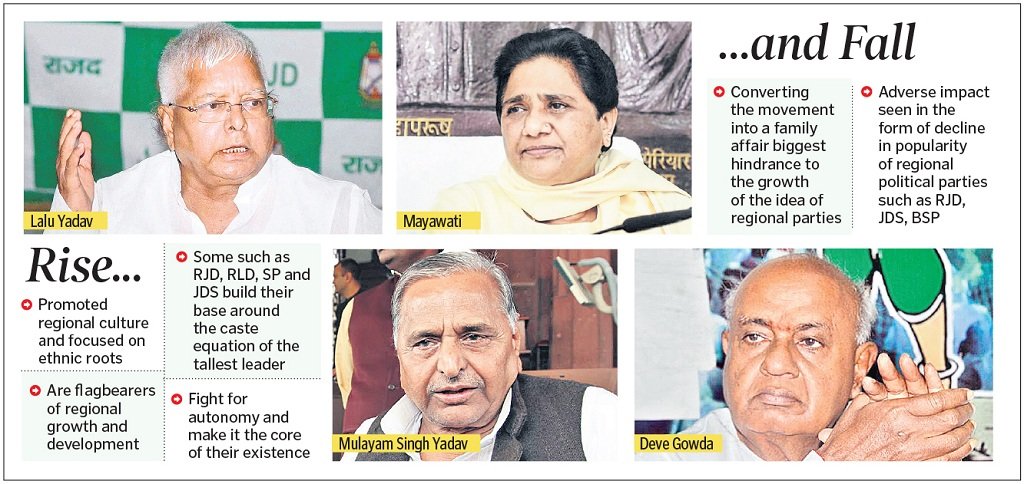Strong regional aspirations power these parties but limiting their leadership to the founder’s family begins the rot
Continuing from yesterday, this part explores each category of regional parties. While some regional parties have the DNA of the INC, many parties follow in the footsteps of the Janata Party.
DNA of INC
The 70s, 80s and the 90s witnessed a decline in the popularity of the Congress. During the same time, INC (Indian National Congress) also saw a rise in the control and command style of functioning. This led to many ambitious regional leaders forming their own parties. The formation of the Telugu Desam Party (TDP) is the classic case as it was a result of the arrogance of the INC central leadership.
Over the years, the inability of the INC to meet the aspirations of its popular regional leaders coupled with its arrogance led to the creation of the All India Trinamool Congress (AITC), Nationalist Congress Party (NCP), YSR Congress Party (YSRCP) and others. The local leaders who enjoyed mass following demanded that they deserved a prominent place in the political landscape and got it by establishing a successful political party.
Most of these regional political parties over the years have become strong regional political dynasties. The genesis of these political parties and the exit of these popular leaders have significantly contributed to the decline in the popularity of the INC.
DNA of Janata Party
The rise of Indira Gandhi as the undisputed leader of India also resulted in the rise of unstructured opposition in the form of Janata Party. The Janata Party movement, which enjoyed a strong mass following and trust of the voters could not manage its growth and popularity.
The biggest problem for the Janata Party was identifying a leader who could efficiently manage the pack of strong, aggressive, passionate and ambitious leaders, who enjoyed a mass following in their respective pockets. The Janata party started to disintegrate even before it reached its full potential, resulting in the rise of regional parties such as Rashtriya Janata Dal (RJD), Samajwadi Party (SP), Janata Dal Secular (JDS), Rashtriya Lok Dal (RLD) and Biju Janata Dal (BJD).
The emergence of these regional parties was a function of regional pride, regional caste equation and, most importantly, ambition of the regional leaders. Most of these regional parties such as RJD, RLD, SP, JDS build their base around the caste equation of the tallest leader.
Demand for Separate State
The third set of regional parties are the ones born out of movements that promoted regional culture and focused on the ethnic roots. The political leaders in Jharkhand, West Bengal, and Telangana agitated for separate States based on their unique regional, cultural, and ethnic traditions.
Over time, the politicians who were agitating for separate States formed a new regional political party. The Jharkhand Mukti Morcha (JMM) in Jharkhand, Telangana Rashtra Samithi (TRS) in Telangana and Gorkha Janmukti Morcha (GJM) in West Bengal were formed as the result of separate statehood movements. The scenario is no different in Maharashtra where the regional party Shiv Sena (SS) followed by the Maharashtra Navnirman Sena (MNS) emerged from a movement in Mumbai demanding preferential treatment for Maharashtrians over migrants to the city.
At times, political parties also fight for autonomy and make it the core of their existence. The National Conference (NC) and the PDP in Jammu and Kashmir are demanding greater autonomy and powers to the State of Kashmir.
Regional Pride and Development
Regional parties also fight for the recognition of cultural rights, unique identity and regional pride. Parties like Shiv Sena in Maharashtra focus on regional rights and pride and the BSP fights for the identity and development of the Dalits.
The Asom Gana Parishad (AGP) is known for fighting the problem of illegal Bangladeshi immigrants in Assam. These set of political parties are flag bearers of regional growth and development.
Fall from Grace
Most of the regional chieftains viz, Deve Gowda, Lalu Prasad Yadav, Mulayam Singh Yadav, Parkash Singh Badal, N Chandrababu Naidu and M Karunanidhi soon after gaining power converted the regional party or the movement into a family affair. This has led to the rise of the regional political family in the last three decades.

We are also witnessing the rise of new political families in Uttar Pradesh and West Bengal as the BSP supremo Mayawati is promoting her brother Anand Kumar and nephew Aakash, and Mamata Banerjee is promoting her nephew Abhishek Banerjee in the party.
This rise of political families is the biggest hindrance to the growth of the idea of regional parties. We are witnessing its adverse impact in the form of decline in the popularity of the regional political parties including the RJD, JDS and the BSP. The decline in the popularity of regional parties and a sudden rise in popularity of a national party is a function of the trust deficit in regional parties.
Also Published at https://telanganatoday.com/trajectory-of-regional-parties


Add a Comment